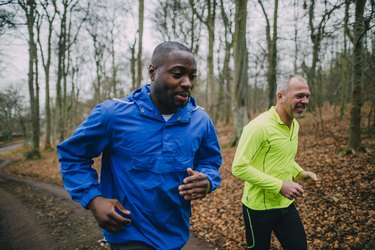
Some would argue that the number one goal of running is to get faster. Set that new personal best (PB). Break the tape at the finish line. Smash a course record.
Running has so many natural benefits, including improving heart health and mental health and even making new friends. But when it comes to racing cross country — especially in high school or college — speed does play a factor in success.
Video of the Day
Video of the Day
So, how do you get faster at cross-country running? Is there a specific technique? Should you try different training routines? Are there high-performance shoes that can give you that edge?
Every cross-country coach has their own philosophy for training and getting faster, but we've tapped a few who share some quality tips for how to run cross-country faster below.
1. Build Up Your Running Foundation
As with any running plan, improving your cross-country speed starts with building a base. The difference with a cross-country foundation is it normally takes a little longer and the timing can fluctuate. While cross-country races can happen at any time of the year, most high school and collegiate seasons happen in the fall, making the summer huge for base training, according to Cole Hester, assistant cross-country and distance track coach at Columbia University in New York City.
"It's like priming the pump to get the lawnmower going," he tells LIVESTRONG.com.
The main focus for these building-block months is to run consistently and occasionally add in some different types of workouts or strides (more on those below), which will eventually help you run faster in cross country.
Gaining aerobic fitness happens in the foundational phase, but also right near the beginning of the season, when the real training begins.
Aerobic exercise means your muscles are receiving an adequate amount of oxygen and energy to continue a long run, notes a February 2017 article in the World Journal of Cardiology. That oxygen and energy output, when developed and matured, can set you up for higher physical conditioning, putting you in a good place to run even faster in cross country.
Cross country in general is a heavily aerobic event. "You're talking about trying to hit an energy system that's predominantly aerobic. And when you hit the other end, after the training, that's where you find yourself getting faster," Hester says.
Working on your aerobic capacity also offers the opportunity to build on miles without worrying too much about pace. The journey to speed actually shouldn't focus so much on the pace. In fact, Dave Ringwood, head coach for cross country and track and field at Cabrini University, says his athletes don't even run with watches or trackers.
2. Do Strides for an Anaerobic Push
Strides are short bursts (10 to 30 seconds) of a faster pace during a run. "They can sharpen the legs without doing a lot of work. You can do something a little bit quick for a short period of time, so when you do go faster, it's not a shock to the body," Hester says.
Strides are anaerobic exercise, which is intense activity for a short period of time, fueled by the energy sources within your working muscles (not by oxygen, like aerobic exercise). Training anaerobically comes in handy for that end-of-the-race kick, Ringwood says.
3. Include Tempos, Intervals and Fartleks in Your Training
To get faster, you also need to mix up your training so your body keeps adapting to different types of stress. Coaches recommend mixing in specific workouts to your training plan, including tempo runs, intervals and fartleks.
Tempos
Tempo runs are consistent efforts performed at about 15 to 30 seconds faster than your average race pace. Hester recommends doing tempo workouts between 5 and 8 miles long to train for cross-country racing.
Tempo runs are the "bread and butter that help you work toward that goal race pace," he says says.
While tempos are definitely increased effort runs, they are by no means all-out. "You're working more and improving aerobic capacity by developing your engine without overly stressing your body," Ringwood says. "You don't get a lot of rest, but that's how you develop — where you're never actually comfortable."
Use This Formula to Craft a Tempo Run
- Warm up at a comfortable pace for 5 minutes
- Push yourself to a pace faster than your half marathon race pace but slower than your 5K or 10K pace. Aim for something that feels like a 6 to 8 out of 10 effort
- Sustain this pace for anywhere from 20 to 40 minutes
- Cool down at a comfortable pace for 5 minutes
Intervals
Interval training structures running into multiple sections with periods of either relative or complete rest. Intervals can vary in distance and intensity.
Running intervals improves your aerobic and anaerobic fitness and can help lessen your time to exhaustion, according to the American College of Sports Medicine's (ACSM) Health & Fitness Journal. This, in turn, improves your cross-country times.
How to Structure Interval Runs
Per the ACSM, you can experiment with short, moderate or long intervals:
- Short intervals: 10 to 60 (about 80 to 600 meters)
- Moderate intervals: 1 to 3 minutes (about 600 meters to 1 kilometer)
- Long intervals: 3 to 15 minutes (about 1 kilometer to 1.5 miles)
Your rest periods may be as long as your working periods if you do short intervals. For moderate and longer intervals, you might rest for a minute or two between repeats.
Fartleks
This type of run — which means "speed play" in Swedish — is a great tool to increase speed over longer distances.
Fartleks are slightly different from intervals in that you're playing around with different distances and speeds for the bulk of your workout versus sticking to one repetitive distance or pace.
This helps you build fitness and get quicker, and it prepares you for the uneven paces of a race, where you might run faster at some points and slower at others, Hester says.
A Sample Fartlek Run
Follow this routine from the International Journal of Physical Education:
- 10-minute warmup at a comfortable pace
- 2 minutes hard
- 2:30 minutes easy
- 3 minutes hard
- 2:30 minutes easy
- 3 minutes hard
- 2:30 minutes easy
- 2 minutes hard
- 10-minute cooldown at a comfortable pace
4. Get Cross-Country-Specific Shoes
Regular road-running shoes would sink entirely if you were running in mud or might slip on grass, which will slow you down, Ringwood says.
You'll want cross-country spikes to rip into grass and help keep you moving forward quickly, Hester says.
Our Favorite Cross-Country Shoes
- Saucony Kilkenny XC9 Men's and Women's ($65, Saucony)
- Hoka All Gender Crescendo XC ($90, Hoka)
- New Balance Unisex XC Seven v4 ($74.99, New Balance)
5. Familiarize Yourself With the Terrain
The terrain for cross-country runners is undeniably differently than road racing. Windy trails, steep hills, sharp turns, mud, grass. This is the kind of terrain that might seem impossible to gain speed on.
Ringwood recommends familiarizing yourself with the types of environments you'll be racing on, such as grass, trails and parks, so you know how to engage your muscles in a different way come race day.
Try to find a variety of workout locations to mimic terrain you might encounter in competition. "It's a good mental stimuli to approach from a different perspective, because during a cross-country race, every minute is going to be different," Ringwood says.
6. Focus on Racing, Not Time
At the end of the day, one key factor to getting faster is to actually not focus on time, but on the race itself. Cross country is unique compared to road or track races in that you may find yourself running in a larger pack, Ringwood says.
"Be aware of your surroundings and who is around you, because you can work off of someone," he says. "Use them as a reference point and find that moment in the race to accelerate."
Results are also hard to speak to, because it's hard to put a time to any one course. When courses range from flat golf courses to hilly, muddy trails, it's more about the competition, not the time, Hester says.
"A track is flat and controlled, and at most 15 to 20 people [in a race]. But in cross country, you can have up to 200 people on the starting line and see all of them, and it's a mad herd of people you're trying to go up against," he says.
Focus on the race at hand and try not to compare your performance from one race to another, because each is so different.
FAQ
Common Questions
What is cross country?
Cross-country running is "a sport in which teams and individuals run races on outdoor courses over natural terrain," like grass, trails or open fields, according to USA Track and Field.
When is cross-country season?
While cross-country races can happen at any time of the year, most high school and collegiate cross-country seasons happen in early fall around September or October.
How many miles do you run in a cross-country race?
A cross-country race differs in mileage depending on the age of the runners. Races for elementary and middle school runners can range from 1.2 to 1.9 miles, according to Hershey Blaze Track Club. A standard high school race is 3.1 miles (a 5K), but high school freshmen may race 2 to 2.5 miles. For National Collegiate Athletics Association (NCAA) runners, women's cross-country races are 3.7 miles long (a 6K) while men's races are 4.9 miles long (an 8K), according to Equaldistance.org, an organization that wants to make collegiate races for all genders an equal length of 8K.
How do you train for a cross-country race?
While every organization's training program may differ, runners should aim to do speed work three days a week, a long run once a week, easy runs two days a week and rest one day a week, according to Hal Higdon's Cross-Country Training Program. This combination helps runners boost their speed and aerobic capacity and cut down on injury risk.
How many miles a week should you run for cross country?
This answer depends on factors like your age, fitness and experience level and the specific program you're following. Most high school cross-country runners average 35 to 45 miles a week, according to Hal Higdon's Cross-Country Training Program. Collegiate cross-country runners can average 70 to 90 miles per week or more, according to Charleston Southern University's men's cross-country team. For individual recommendations, chat with your cross-country coach to see what's right for you.
What is the difference between track and cross country?
The biggest difference is the type of terrain you run on. Cross-country races are typically off-road courses, while track races happen on a track. Other differences include the lengths of the races, competition structure and scoring.
- International Journal of Physical Education: "Effect of fartlek training for developing endurance ability among athletes"
- World Journal of Cardiology: "Aerobic vs anaerobic exercise training effects on the cardiovascular system"
- American College of Sports Medicine's Health & Fitness Journal: "Interval Training"
- Hershey Blaze Track Club: "Blaze Cross Country"
- Equaldistance..org: "Equal race distance for all genders"
- USA Track and Field: "Cross Country"
- Hal Higdon Cross-Country Training Program: "About the Cross Country Program"


